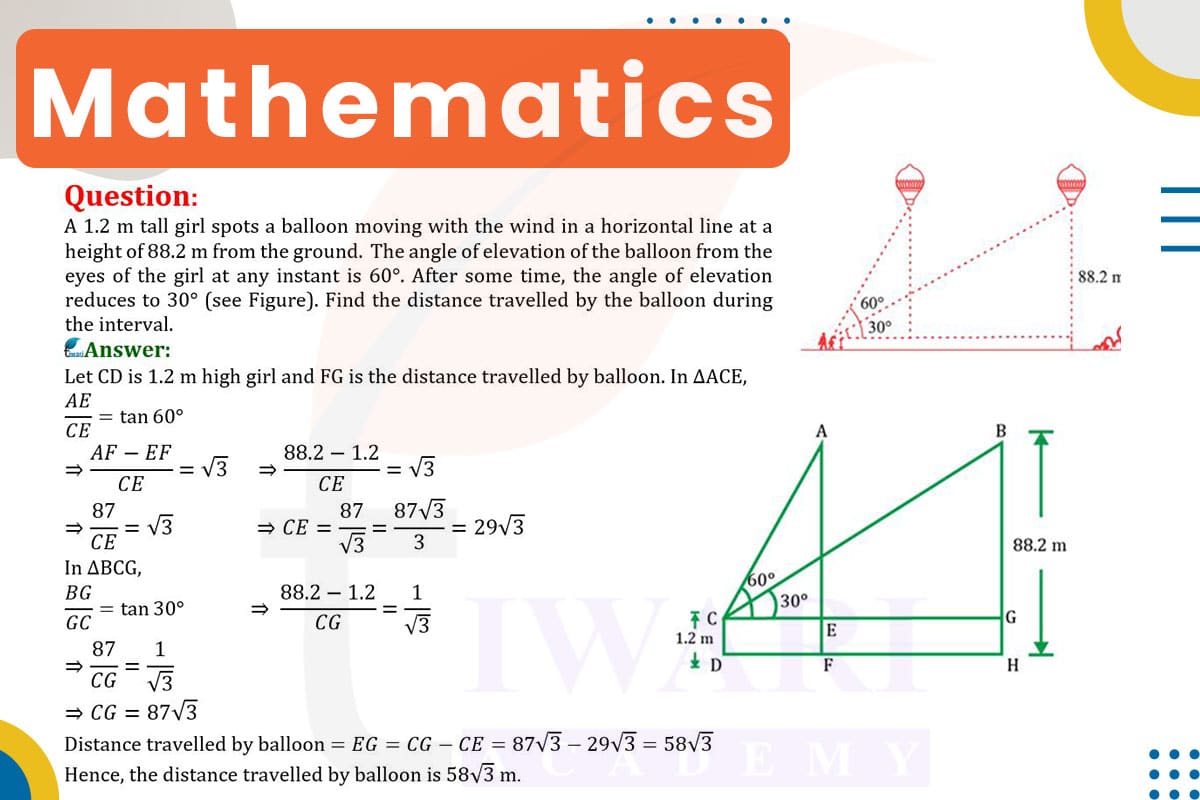To find the distance traveled by the balloon, we use trigonometry. Let’s denote the initial and final distances from the girl to the balloon as d1 and d2, respectively.
Initial Position (60° Angle of Elevation): The height of the balloon from the girl’s eyes is 88.2 m − 1.2 m = 87 m. Using tan(60°) = √3, the equation is √3 = 87/d1. Solving for d1, we get d1 = 87/√3.
Final Position (30° Angle of Elevation): Using tan(30°) = 1/√3, the equation is 1/√3 = 87/d2. Solving for d2, we get d2 = 87√3. The distance traveled by the balloon is d2 − d1 = 87√3 − 87/√3, which simplifies to approximately 101.82 meters. Therefore, the balloon traveled about 101.82 meters during the interval.

Let’s discuss in detail
Trigonometric Application in Motion Analysis
Trigonometry, a branch of mathematics, is extensively used in analyzing motion, especially in scenarios involving angles and distances. The problem at hand involves a balloon moving horizontally at a certain height and a girl observing it from the ground. By using the angles of elevation at different instances, we aim to calculate the distance traveled by the balloon. This scenario is a practical demonstration of how trigonometry can be applied to solve real-world problems in physics and engineering, particularly in motion analysis and tracking moving objects.
Understanding the Problem: Balloon Observation
The problem presents a 1.2-meter-tall girl observing a balloon that is initially 88.2 meters above the ground. The angle of elevation from the girl’s eyes to the balloon changes from 60° to 30° over a period. The objective is to determine the distance the balloon has traveled during this interval. This setup forms two right-angled triangles at different instances – one at the initial position (60° angle) and the other at the final position (30° angle).
The Role of Tangent in Angle of Elevation
In trigonometry, the tangent of an angle in a right-angled triangle is the ratio of the length of the opposite side (height difference between the girl’s eyes and the balloon) to the length of the adjacent side (horizontal distance from the girl to the balloon). By applying the tangent function to the given angles of elevation, we can calculate the distances of the balloon from the girl at both the initial and final positions.
Calculating the Initial Distance
For the initial position with a 60° angle of elevation, we use the formula tan(60°) = √3. The height difference is 88.2 m − 1.2 m = 87 m. So, √3 = 87/d1, where d1 is the initial distance. Solving for d1, we find d1 = 87/√3 meters.
Determining the Final Distance
At the final position with a 30° angle of elevation, we apply the formula tan(30°) = 1/√3. The equation becomes 1/√3 = 87/d2, where d2 is the final distance. Solving for d2, we find
d2 = 87√3 meters.
Calculating the Distance Traveled by the Balloon
The distance traveled by the balloon is the difference between d2 and d1, which is 87√3 − 87/√3 meters. This calculation simplifies to approximately 101.82 meters. This example illustrates the practical application of trigonometry in motion analysis, demonstrating its importance in tracking and measuring the movement of objects. Trigonometry provides a reliable mathematical approach to solving problems where direct measurement of distance is challenging, ensuring accuracy and efficiency in analysis and planning.
Discuss this question in detail or visit to Class 10 Maths Chapter 9 for all questions.
Questions of 10th Maths Exercise 9.1 in Detail


